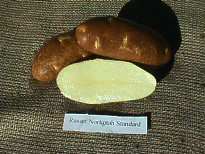
 |
Description | |
| Tuber Shape | Oblong to Long | |
| Eyes | Shallow evenly distributed eyes | |
| Skin | Smooth medium russet | |
| Flesh | White | |
| Plant | Small to medium sized upright vine with white flowers | |
Plant/roots Plant is fast emerging with a medium, slightly upright vine and white flowers; it has adeterminate growth habit with a shallow, concentrated root system; it is very susceptible to haildamage with little or no re-growth of vines.
Tubers are white flesh, long to slightly oblong with medium to heavy russeted skin. Eyes areshallow, numerous and well distributed; medium specific gravity (1.085). Although not consideredsuitable as a processing potato, it will fry directly from the field.
Yield potential 450 to 500 cwt. range with a high percentage of No. l's.
Irrigation Irrigation interval at the maximum ET is 2.5 days. Drought tolerance is poor;significant yield reduction occurs if plants are moisture stressed. Adequate irrigation applied atshort intervals coupled with high early season fertility will help this cultivar develop necessaryvine growth prior to tuberization. After tuberization, vine growth often slows dramatically. Subsequent rapid tuber bulking and early vine senescence results in minimum late season waterrequirements. Growers should strive to avoid late season overwatering since it creates idealconditions for expression of many diseases such as blackleg or leak.
Fungicides Three to five fungicide applications may be necessary to control foliar early blight.
Tuberization/bulking Tuber set is light to medium, high in the hill. Greening may be a problemwithout good hill management. Tuber bulking occurs in a short interval during early to mid-season at an extremely rapid rate. Russet Norkotah is moderately resistant to blackspot andresistant to growth cracks, second growth and hollow heart.
Vine Kill Average days from planting to vine kill are 95 to 110. Vine killing usually is notrequired.
However, if senescence is not complete, vines are killed easily; adequate skin set occurs in 12 to
21 days. Tubers can become large late in the season, so close monitoring is necessary after early
August.
Bacterial Ring Rot symptom expression is erratic and difficult to see under most circumstances. Symptoms are mild and tend to appear only after vines begin senescing (90 + days after planting). Reaction to PVY infection is mild to latent. Infected plants are difficult to detect early in thegrowing season, but usually express mild symptoms that become somewhat more detectable asthe plants age. Infected plants tend to die by mid-season with potentially significant yield losseswhen PVY incidence is high.
Toxic-seedpiece-decay syndrome is characterized by severe plant wilting just prior to tuberization,when the plants are switching from seedpiece nutrition to their root system. Plants appear windburned with dehydrated leaf margins in the upper canopy. A light brown, jelly-type rottedmass is all that is left of the seedpiece and brown streaks may be visible in the lower stem. Normally the plant recovers within a couple of weeks. This problem may be present when earlyseason wet conditions are linked with warm weather.
Disease reaction ratings susceptible, moderately susceptible, moderate, moderately resistant and resistant.
Note: This information should only be used as a guide. Adjustments for local conditions must always be made.
Field
Storage Foliar early blight: Susceptible
Tuber early blight Moderate Verticillium wilt: Susceptible
Bacterial soft rot Susceptible Blackleg Susceptible
Fusarium dry rot Susceptible Seedpiece decay Susceptible
Leak (Pythium) Susceptible Leafroll virus Susceptible
Pink rot (Phytophthora) Susceptible Leafroll Net necrosis Susceptible
Silver scurf Susceptible PVY, PVX Susceptible
Rhizoctonia scurf Moderate Bacterial ring rot Susceptible
Common Scab Moderately Resistant